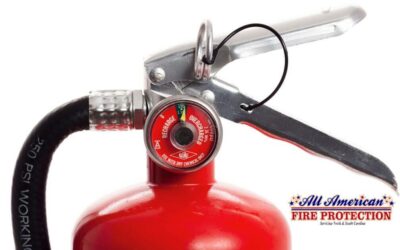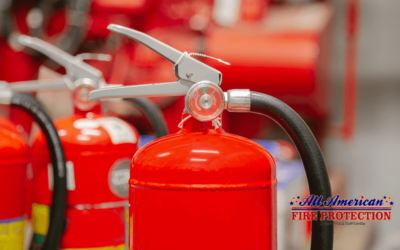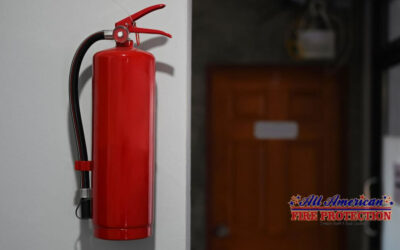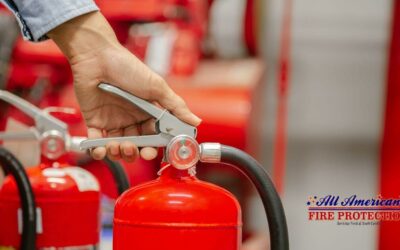Understanding Fire Extinguisher Categories
Fire extinguishers are more than just handy tools in the fight against fires; they are vital components of any home safety plan, a principle strongly advocated by All American Fire Protection, experts in fire extinguishers. However, it’s crucial to understand that not all fire extinguishers are created equal. They are divided into distinct categories, each designed to combat specific types of fires. These categories are Class A, Class B, Class C, Class D, and Class K. Each class of extinguisher is uniquely equipped to handle different fire scenarios. By understanding these categories, you can ensure you have the right fire extinguisher for each area of your home, enhancing your overall fire safety. Let’s explore each of these categories in more detail in the following sections.
Class A Fire Extinguishers
Class A fire extinguishers are your first line of defense against fires involving ordinary combustible materials. These materials are often found in most homes and include items such as paper, wood, cloth, rubber, and certain plastics.
The extinguishing agent in a Class A fire extinguisher is typically water or specific dry chemicals. You can identify Class A fire extinguishers by their green triangle symbol containing the letter ‘A’.
However, it’s worth noting that Class A fire extinguishers are not suitable for all types of fires. For instance, using a Class A extinguisher on fires involving flammable liquids, gases, or electrical equipment can exacerbate the situation. These types of fires require the unique capabilities of other classes of fire extinguishers, which we’ll explore in the subsequent sections.
In a nutshell, while Class A fire extinguishers are excellent for general home use, they should be part of a broader fire safety strategy that includes other classes of fire extinguishers. This approach ensures you’re prepared for a variety of fire emergencies.
Class B and C Fire Extinguishers
When it comes to fires fueled by flammable liquids or gases such as gasoline, oil, or solvents, Class B fire extinguishers are your go-to solution. These extinguishers, identifiable by a red square with the letter B, are often found in areas like garages or storage spaces where these substances are stored. The extinguishing agents in Class B extinguishers act as smothering agents, creating a barrier between the fuel and oxygen, effectively suffocating the fire.
In contrast, Class C fire extinguishers, marked by a blue circle with the letter C, are designed to handle fires involving energized electrical equipment. Think of short-circuited kitchen appliances or overloaded power strips. Unlike Class A extinguishers, Class C extinguishers utilize non-conductive agents, mitigating the risk of electric shock when deployed on an electrical fire.
Choosing the right mix of Class B and C fire extinguishers is essential for your home’s fire safety, ensuring you’re prepared for specific fire emergencies.
Class D and K Fire Extinguishers
Class D fire extinguishers, marked by a yellow decagon with the letter D, are specialized for fires involving combustible metals such as magnesium, potassium, or sodium. While not common in most homes, they are vital in certain workshops or labs where these metals are used. The extinguishing agents in Class D extinguishers form a crust over the burning metal, cutting off the oxygen supply and extinguishing the fire.
On the other hand, Class K fire extinguishers, identifiable by a black hexagon with the letter K, are designed to tackle fires caused by cooking oils and fats. While traditionally found in commercial kitchens, they are becoming increasingly popular in homes due to their effectiveness against grease fires. The agent in a Class K extinguisher is discharged as a fine mist, which cools the fire and reacts with the oil to form a soapy substance, putting out the flames.
Properly selecting and positioning Class D and K fire extinguishers can greatly enhance fire safety in homes with specific fire risks.
Selecting Home Fire Extinguishers
Choosing the appropriate fire extinguisher for your home is a task that requires careful consideration. The potential fire hazards in each area of your home are unique and may necessitate different types of fire extinguishers. It’s not uncommon for a household to need more than one kind of extinguisher to adequately cover all possible fire risks. The right extinguisher can mean the difference between a minor fire scare and a catastrophic blaze. In the following sections, we’ll explore the ideal fire extinguishers for various areas in your home, including the kitchen, garage or workshop, living spaces, and laundry room.
Kitchen Fire Extinguishers
The kitchen, with its cooking appliances and flammable oils, is a common site for home fires. While Class K extinguishers are designed to combat fires involving cooking oils and fats, they are typically used in commercial kitchens. For residential kitchens, a more practical option is a multipurpose ABC fire extinguisher.
An ABC fire extinguisher is versatile, capable of tackling Class A fires (involving common combustibles like wood and paper), Class B fires (involving flammable liquids and gases), and Class C fires (involving electrical equipment). This versatility makes it an ideal choice for the kitchen, where a fire could involve any combination of these elements.
Placement is also a crucial aspect of fire safety. It’s recommended to position the extinguisher near the kitchen exit. This allows you to combat the fire while maintaining a clear escape route, should the fire escalate beyond control.
Investing in the right fire extinguisher for your kitchen is a proactive step towards protecting your family and minimizing potential property damage from kitchen fires.
Garage or Workshop Fire Extinguishers
In the realm of home safety, garages and workshops often pose a unique set of challenges. These areas are typically filled with a mix of combustible materials, flammable liquids, gases, and electrical equipment, creating a potential hotbed for fires of various classes. To combat this, a versatile fire extinguisher is required, and the ABC fire extinguisher fits the bill perfectly.
The ABC fire extinguisher is a jack-of-all-trades, capable of tackling Class A, B, and C fires, making it a prime choice for most garage or workshop fire scenarios. However, if your workspace contains unique metals such as magnesium or sodium, you might need to consider a Class D fire extinguisher, known for its efficacy against metal fires.
Placement is key when it comes to fire extinguishers. Ensure that it’s easily accessible, highly visible, and close to an exit for a quick escape if needed. With the right fire extinguisher in place, you can enjoy your hobbies or park your vehicles with an added layer of safety.
Living Spaces Fire Extinguishers
Living spaces like bedrooms, living rooms, and dining rooms are often the heart of the home, where family members spend a significant amount of time. These areas are usually filled with Class A combustibles such as furniture, carpets, and drapes, making a Class A fire extinguisher a suitable choice.
However, given the likelihood of electrical equipment and appliances in these spaces, an ABC fire extinguisher could be a more prudent choice. This type of extinguisher is equipped to handle Class B and C fires as well, providing broader protection.
Just like in other areas of the home, the placement of the fire extinguisher in living spaces is crucial. It should be located in a central, accessible spot, away from potential fire sources but within easy reach in case of a fire. Remember, a swift response can be pivotal in containing a fire, so having the right fire extinguisher readily available is a crucial component of your home’s fire safety strategy.
Laundry Room Fire Extinguishers
While laundry rooms may not be the first place that comes to mind when considering fire risks, they can indeed be a potential hotspot for fires. The combination of electrical appliances and flammable substances, such as cleaning chemicals or materials, makes them vulnerable to both Class B and Class C fires.
Given this, an ABC fire extinguisher is a wise choice for laundry rooms. This type of extinguisher is designed to tackle fires from a variety of sources, including those that may arise in this space. Moreover, it’s also capable of handling Class A fires, which can be caused by common combustible materials like clothes.
Placement of the fire extinguisher is key. It should be positioned in a spot that is easy to reach in the event of a fire. A recommended location would be near the exit door, allowing you to address the fire without the risk of becoming trapped.
Equipping your laundry room with the appropriate fire extinguisher can help transform a potentially dangerous situation into a manageable one.
Fire Extinguisher Use and Maintenance
Securing the right fire extinguishers and positioning them strategically throughout your home is a vital part of your fire safety strategy. But it doesn’t end there. Knowing how to properly use these devices and maintaining them regularly is just as important.
In this section, we’ll walk you through the correct way to use fire extinguishers. We’ll also provide you with essential maintenance tips to ensure your extinguishers remain in working order and ready to perform when you need them most.
Proper Use of Fire Extinguishers
In the event of a fire, understanding the correct operation of a fire extinguisher can be a lifesaver. The difference between a minor fire incident and a major disaster can hinge on this knowledge.
The acronym PASS provides a simple guide to extinguisher use: Pull, Aim, Squeeze, and Sweep.
Start by Pulling the pin, which breaks the tamper seal.
Aim low, directing the extinguisher’s nozzle or hose towards the fire’s base.
Squeeze the handle, releasing the extinguishing agent.
Lastly, Sweep the nozzle side to side at the fire’s base until it is extinguished.
While using the extinguisher, maintain a safe distance and ensure your back is towards a clear exit path. If the fire cannot be extinguished, prioritize personal safety and evacuate.
Recognize when evacuation is necessary. If the flames are taller than you, if they obstruct your escape routes, or if the air is thick with smoke, evacuate immediately.
Fire extinguishers are powerful tools in fire prevention, but their effectiveness is greatly enhanced when used correctly.
Fire Extinguisher Maintenance
Maintaining your fire extinguisher in good condition is crucial to ensure its readiness for use in an emergency. Regular checks should include an inspection of the pressure gauge, which indicates if the extinguisher has sufficient pressure to function effectively.
Regularly inspect the extinguisher for physical damage such as corrosion, leakage, or a clogged nozzle. If you detect any significant damage or issues, it’s safest to replace the extinguisher.
For dry chemical extinguishers, perform a shake routine monthly. This gentle end-to-end motion helps prevent the chemical powder inside from compacting.
Annual professional inspections are also recommended. These inspections can identify issues not easily detected in a routine check, ensuring your fire extinguisher is always ready for action.
After use, even if it was only partially discharged, remember to replace or service your extinguisher according to the manufacturer’s instructions.
Proper maintenance of your fire extinguisher ensures that you have a dependable tool at your disposal should a fire occur in your home.







